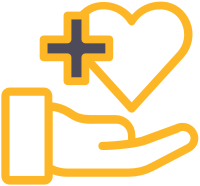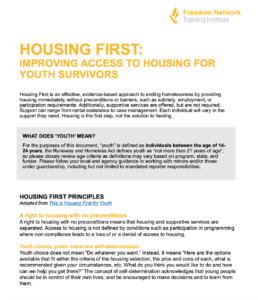The Resource Library includes fact sheets, promising practices, tools, templates, and training materials developed by subject-matter experts with direct experience working with survivors. Resource topics address current trends and challenges in the field.
Search Results 17 matching results for "Promising Practices"
Guide for Applying for Credit Repair under the Debt Bondage Repair Act
This guide aims to assist practitioners and survivors in applying for relief under the Debt Bondage Repair Act (DBRA). The DBRA allows survivors of human trafficking to block adverse credit information, resulting from their trafficking victimization, from their credit files. The primary objective of this guide is to facilitate the navigation of this process by providing samples and offering context on why specific information is being requested.
See the full guide for sample letters
Levels: Introductory
Material Types: Promising Practices Tools
Types of Trafficking: Labor Trafficking Sex Trafficking
Keywords: Credit Repair
Demographics: Adults Foreign National US Citizen/Legal Permanent Resident Youth
Applying the Five Tiers of Economic Empowerment to Anti-Trafficking Housing Programs
This resource will provide multiple strategies to support trafficking survivors’ education and employment growth. Utilizing the Futures Without Violence Five Tiers of Economic Empowerment model, service providers can implement economic empowerment throughout a
range of shelter and housing options. The guidance provided within the document will include ways that these tiers can be woven into short, medium, and long-term housing services.
Levels: Intermediate
Material Types: Promising Practices Toolkit
Types of Trafficking: Labor Trafficking Sex Trafficking
Keywords: Economic Empowerment Housing Housing Assistance Job Assistance Skill Development
Demographics: Adults
Labor Trafficking Considerations for Housing Providers
Labor Trafficking is often under-identified due to a lack of training and awareness. Survivors of labor trafficking may be eligible for resources such as housing, case management, immigration relief, record expungement, public benefits, and restitution through both civil and criminal courts. Throughout this document, we will briefly cover how housing programs can begin to identify and define labor trafficking, screen for labor trafficking, and incorporate practices that include labor trafficking survivors seeking housing services.
Levels: Introductory
Material Types: Fact Sheets Promising Practices
Types of Trafficking: Labor Trafficking
Keywords: Forced Labor Housing Screening
Demographics: Adults
Housing Navigators: An Innovative Strategy to Improving Housing Access for Trafficking Survivors
Housing Navigators are one strategy for assisting survivors of trafficking who face unique housing
barriers. This resource will provide an overview of the Housing Navigator position, explain the specific responsibilities of the position, and how those duties can be implemented within anti-trafficking housing programs.
Levels: Introductory
Material Types: Promising Practices
Types of Trafficking: Labor Trafficking Sex Trafficking
Keywords: Housing Housing Navigation Promising Practices
Demographics: Adults
Re-Centering Sex Worker Safety in Anti-Trafficking Work: Perspectives from the Field.
Freedom Network USA (FNUSA) and the National Survivor Network (NSN) have developed the following guidelines to help anti-trafficking organizations work more collaboratively with sex worker safety advocates, some of whom experienced human trafficking, and to reduce harm that anti-trafficking efforts cause to those in the sex trades.
Levels: Advanced Intermediate Introductory
Material Types: Promising Practices Reports Tools
Types of Trafficking: Labor Trafficking Sex Trafficking
Keywords: Awareness Case Management Foreign Nationals Legal Services Policy Program Management Promising Practices Public Health Safety Planning Sex Work Trauma Informed
Demographics: Adults Foreign National LGBTQIA+ Men and Boys US Citizen/Legal Permanent Resident
Voluntary Services FAQ
This FAQ addresses frequently asked questions from anti-trafficking housing providers regarding implementing a voluntary services model in shelter and housing programs.
Levels: Intermediate
Material Types: Fact Sheets Promising Practices
Types of Trafficking: Labor Trafficking Sex Trafficking
Keywords: Housing
Demographics: Adults Foreign National LGBTQIA+ Men and Boys US Citizen/Legal Permanent Resident Youth
Screening Guidelines for Housing Programs
This document provides anti-trafficking service providers with tips on best practices for screening trafficking survivors for housing programs. This resource includes information about screening in, eligibility criteria, and warm referrals when working with housing survivors of trafficking.
Levels: Introductory
Material Types: Promising Practices Tools
Types of Trafficking: Labor Trafficking Sex Trafficking
Keywords: Housing Promising Practices
Housing Intake Template
This template provides a fillable questionnaire to assist anti-trafficking service providers with completing a housing intake with a survivor. This resource includes questions about survivor health and wellbeing, safety, and housing needs.
Levels: Introductory
Material Types: Promising Practices Tools
Types of Trafficking: Labor Trafficking Sex Trafficking
Keywords: Housing Promising Practices
Intake Guidelines for Anti-Trafficking Housing Programs
This intake guide gives anti-trafficking service providers information on how to best conduct a survivor intake into a housing program. This resource includes recommendations on questions to ask at intake, ways to conduct a successful intake.
Levels: Introductory
Material Types: Promising Practices Tools
Types of Trafficking: Labor Trafficking Sex Trafficking
Keywords: Housing Promising Practices
Housing First: Improving Access to Housing for Youth Survivors
This fact sheet discusses the principles of Housing First, and how these principles benefit youth survivors of trafficking.The fact sheet also makes suggestions on best practices when working with youth survivors of trafficking, and how these practices can be implemented.









